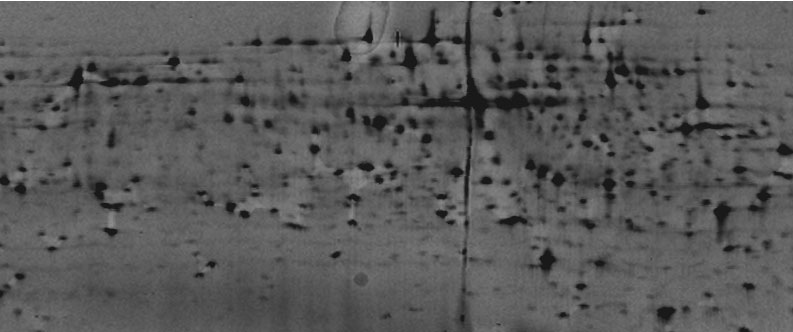Proteomics
 Two-dimensional electrophoresis (2DE) gels have been widely used to separate proteins and to study their differential expression across treatment groups. Due to its capacity to separate thousands of proteins at a relatively low cost, 2D electrophoresis gel remains the method of choice for pre-screening differentially expressed proteins. We work with Dr. Anindya Roy at UMBC and use exploratory data analysis methods to detect differentially expressed proteins in 2DE. Our work in this area is in collaboration with the Georgetown University – the group led by Dr. Francoise Seillier-Moiseiwitsch.
Two-dimensional electrophoresis (2DE) gels have been widely used to separate proteins and to study their differential expression across treatment groups. Due to its capacity to separate thousands of proteins at a relatively low cost, 2D electrophoresis gel remains the method of choice for pre-screening differentially expressed proteins. We work with Dr. Anindya Roy at UMBC and use exploratory data analysis methods to detect differentially expressed proteins in 2DE. Our work in this area is in collaboration with the Georgetown University – the group led by Dr. Francoise Seillier-Moiseiwitsch.
Active Projects:
-
Beyond Spots and Peaks: Integrated Analytical Methods in Proteomics
Funded by NIH-NIGMS (Grant Number: 5R01GM075298-02)
Project team:
-
Haleh Safavi, Nicolle Correa, Dr. Tülay Adali, Dr. Anindya Roy, Dr. Francoise Seillier-Moiseiwitsch
Recent publications:
- H. Safavi, N. Correa, W. Xiong, A. Roy, T. Adali, V. R. Korostyshevskiy, C. C. Whisnant, and F. Seillier-Moiseiwitsch, "Independent component analysis of 2-D Electrophoresis gels", Electrophoresis, vol. 29, no. 19, pp. 4017--4026, 2008. In this work, we present a novel method to detect differentially expressed proteins in simulated and real two dimensional electrophoresis (2DE) gels using different independent component analysis (ICA) algorithms. We use ANOVA as a benchmark for comparison. We also use ICA on wavelet transformed 2DE gels to increase in speed of performance and improving performance for misaligned gels.
- N. Correa, H. Safavi, W. Xiong, A. Roy, T. Adali, and F. Seillier-Moiseiwitsch, "Independent component analysis of simulated 2D electrophoresis gels," in Proc. IEEE Workshop on Machine Learning for Signal Processing (MLSP), Maynooth, Ireland, Sep. 2006.
Resources:
-
Simulated gel dataset (Matlab code)
